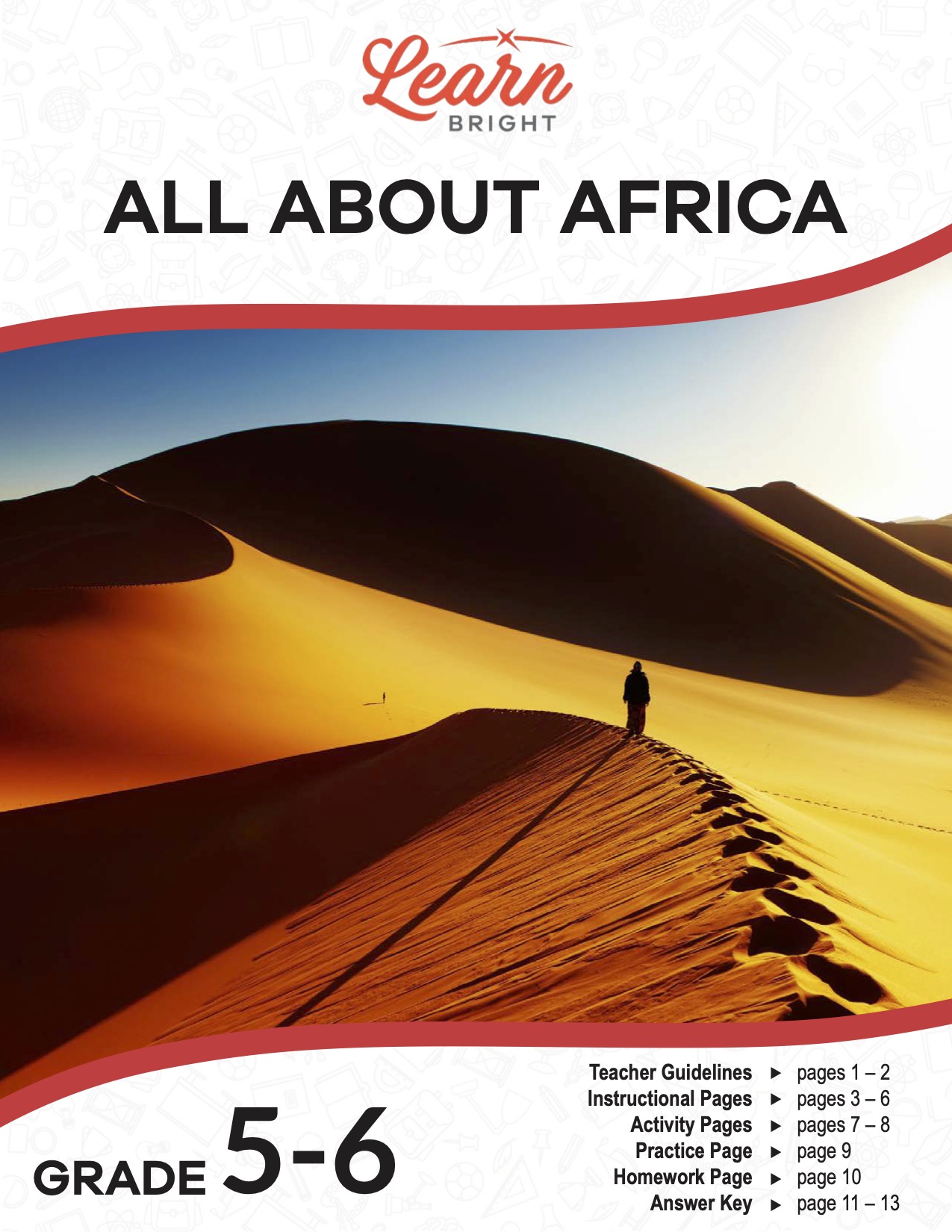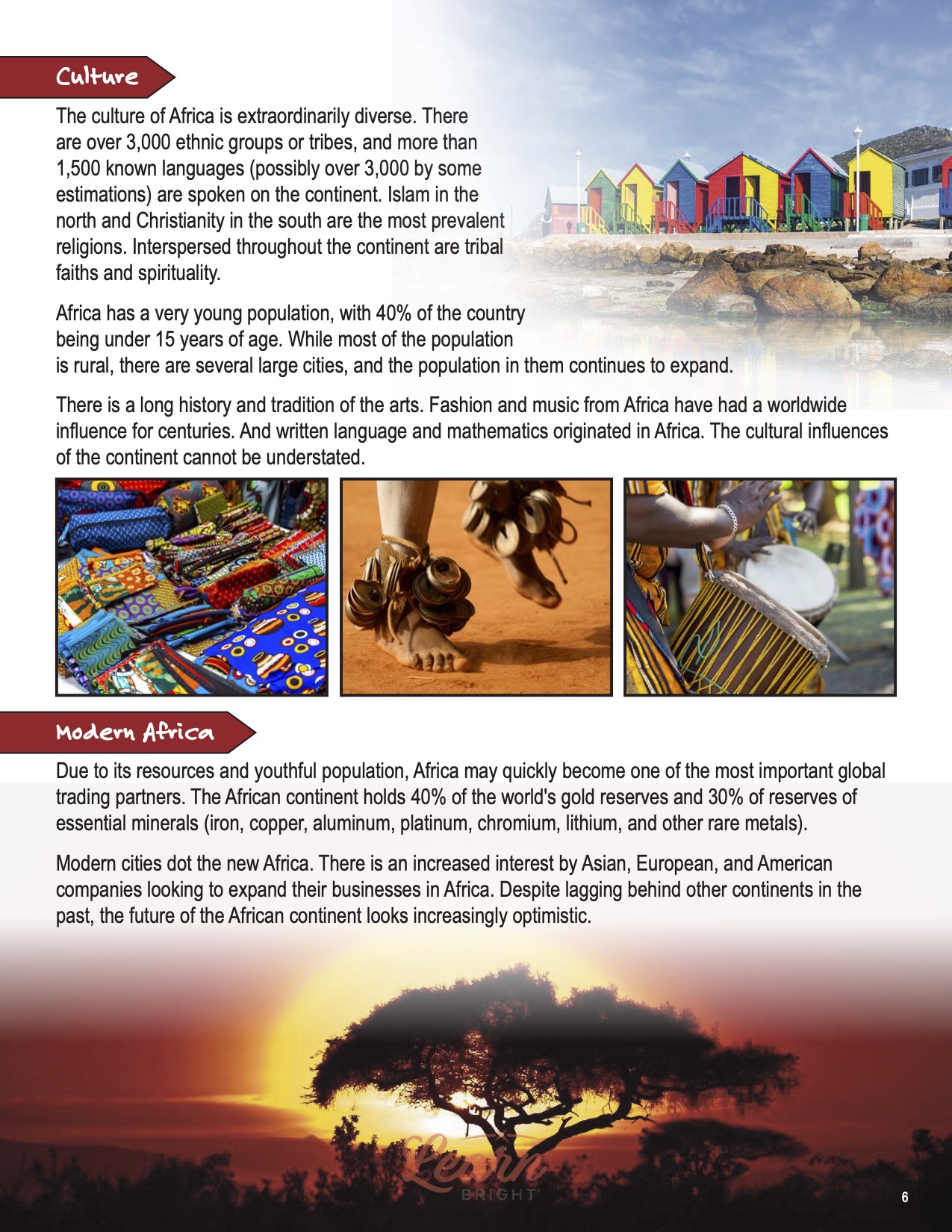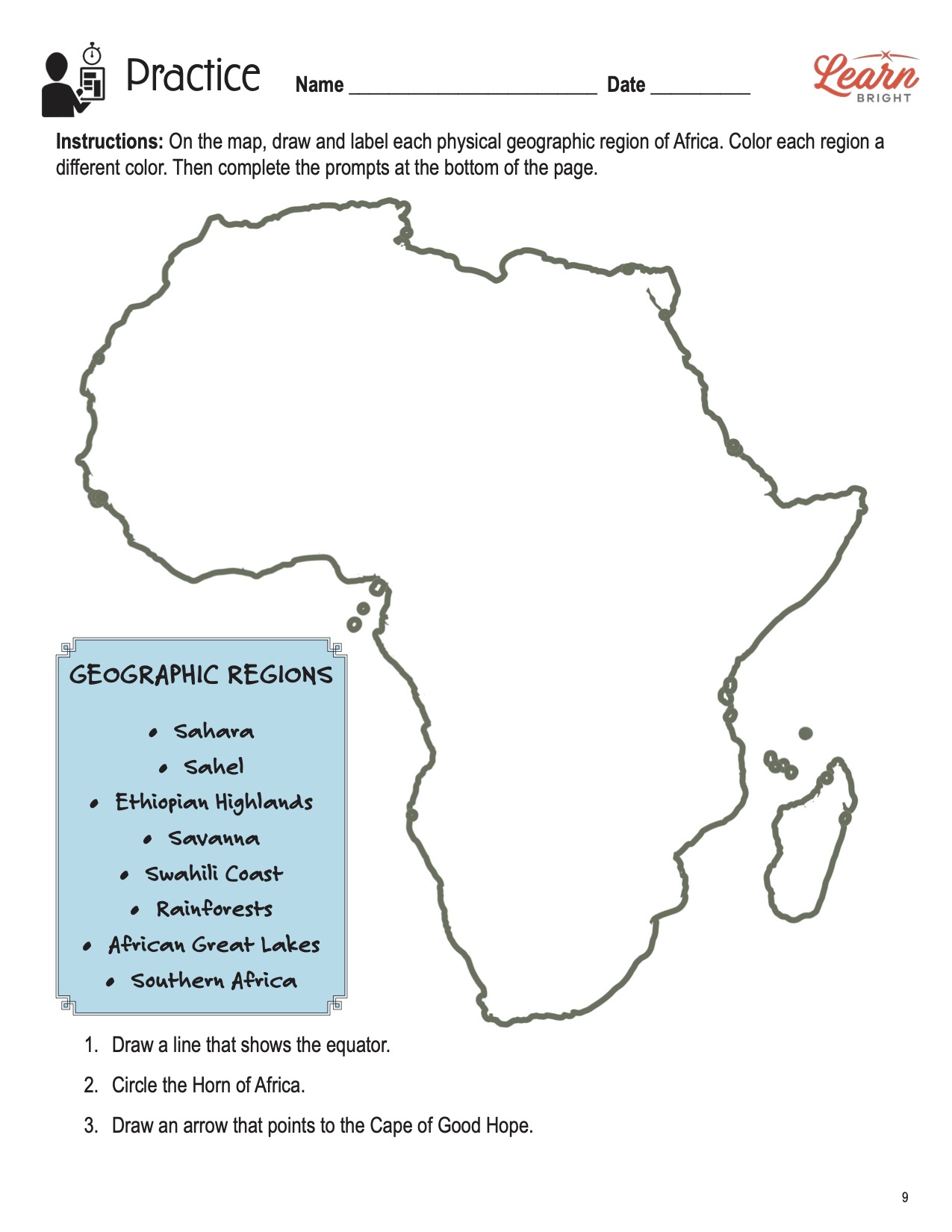Description
What our All about Africa lesson plan includes
Lesson Objectives and Overview: The All about Africa lesson plan teaches students about the location, history, and culture of Africa. Students will discover specific facts about the continent’s geography, government, and economy. Students will also have the opportunity to research one of the 54 African countries. This lesson is for students in 5th grade and 6th grade.
Classroom Procedure
Every lesson plan provides you with a classroom procedure page that outlines a step-by-step guide to follow. You do not have to follow the guide exactly. The guide helps you organize the lesson and details when to hand out worksheets. It also lists information in the yellow box that you might find useful. You will find the lesson objectives, state standards, and number of class sessions the lesson should take to complete in this area. In addition, it describes the supplies you will need as well as what and how you need to prepare beforehand. This lesson requires colored pencils, poster paper, a map of Africa, and scratch paper. Students will also need access to the internet for part of the lesson.
Options for Lesson
Check out the “Options for Lesson” section of the classroom procedure page for additional suggestions for ideas and activities to incorporate into the All about Africa lesson. National Geographic (NAT GEO) has excellent resources to show students stunning photos of Africa. Gather images from NAT GEO or similar magazines to display. Find someone who has lived in Africa at some point (missionaries or humanitarian workers, for example). Have your students interview them. Be sure to visit the Learn Bright channel on YouTube to find the video that matches this lesson and show it to students.
Teacher Notes
The paragraph on this page provides a little more information or guidance on what to expect from the lesson. It mentions that this lesson is not all encompassing but aims to give students an overview and basic knowledge about the continent of Africa. You could choose to teach this lesson in conjunction with others about the other continents of the world. Use the blank lines to record any thoughts or ideas you have as you prepare.
ALL ABOUT AFRICA LESSON PLAN CONTENT PAGES
Continent of Africa
The All about Africa lesson plan has four pages of content. Africa is a continent, not a country. The African Union and the United Nations recognize 54 countries on the continent. Each country has a flag that represents an independent nation. Africa is called the “Cradle of Humankind.” This is because fossil evidence indicates that the closest relatives to human beings, and human beings themselves, evolved from Africa. About 16% of the world’s population (over 1.2 billion) live in Africa.
Africa is the second largest continent in the world. It is surrounded by the Mediterranean Sea, the Red Sea, the Indian Ocean, and the Atlantic Ocean. Africa is divided almost equally by the equator. The equator divides the earth into the Northern and Southern Hemispheres. Africa is roughly 11,724,000 square miles (30,365,000 square kilometers), which is nearly 5,000 miles north to south and 4,700 miles east to west.
Geography—Sahara, Sahel, Ethiopian Highlands, Savanna, and Swahili Coast
There are eight major physical geographical regions. Each has unique characteristics that distinguish it from the others. The Sahara is the first region. It is the largest hot, dry desert in the world and covers about 25% of the African continent. As you might imagine, geographical areas don’t begin and end precisely in one location. Geographical regions have transition areas between them. A narrow strip of land occupies the space between the Sahara and savannas. It is a semi-arid land known as the Sahel, the second region.
Next is the region of the Ethiopian Highlands. More than 75 million years old, the Ethiopian Highlands include 80% of the tallest mountains in Africa. Surrounding the highland areas is the Savanna region. The savannas are the grasslands of Africa. They cover about half of Africa and are where several species of animals live that you may be familiar with.
The Serengeti is the best-known savanna. Here, you could find lions, giraffes, and elephants, and wildebeests grazing on the grass. Along the Indian Ocean from Somalia to Mozambique is region called the Swahili Coast. It is about 1,000 miles long and contains several coral reefs and barrier islands.
Geography—Rainforests, Great Lakes, and Southern Africa
Rainforests make up 80% of central Africa. Unfortunately, this sensitive area of enormous ecological value is threatened and shrinking. The rainforests contain the most diverse plant and animal life on the planet. Although more than 8,000 species of plants have been identified, scientists believe that they only represent 10% of the plant life species in the African rainforests.
Africa is home to some of the world’s largest and deepest lakes. The African Great Lakes region has seven significant lakes. The largest of these and the second-largest freshwater lake worldwide, Lake Victoria, feeds the Nile River, the longest river in the world. You would also find the world’s longest waterfall in this area—Victoria Falls.
Southern Africa is the last region. It is a mix of mountains and plateaus. The Kaapvaal Craton, a shelf of bedrock over 2.6 billion years old, forms the base of Southern Africa. The area is home to a diverse mix of animal and plant species. South Africa’s national flower (king protea) is found in the Cape Floral Region of Southern Africa.
History
It would take several volumes to record the history of an entire continent! Let’s sum it up. Some scientists believe hominids occupied Africa 4 million or more years ago. Hominids are the earliest-known ancestors of humans. Humans appeared about 100,000 years ago in the eastern region of sub-Saharan Africa. They would later migrate north and fan out across the Middle East, then to the rest of the world.
Around 3000 BCE, one of the greatest kingdoms in history, Egypt, appeared along the Nile River Valley. Other significant cultures include the Phoenicians, who established several flourishing cities in what is now present-day Tunisia, and Carthage, a town on the Mediterranean. The Phoenicians were renowned sailors and are said to have sailed around Africa and visited Asia.
The Romans dominated northern Africa for several centuries after a civil war with the Ptolemies and Cleopatra’s death. Egypt was annexed by the Roman Empire in 30 BCE and remained a province until about 641 CE.
Ghana was the first known empire in western Africa (in power from 5th to 11th century CE). Several territories came under Muslim rule. Mali and Songhai were two powerful West African states under Muslim influence. Both were known for their aggressive trade practices and dominance over the trade routes in Africa.
Transatlantic Slave Trade and Independence
The Transatlantic Slave Trade began in 1526 and remained operational until 1867. Several European countries participated in capturing, selling, enslaving, and forcing labor on more than an estimated 12.5 million people. Historians estimate that more than 10 million enslaved people were sent to the Caribbean and North and South Americas.
During the late 19th century, Europe began to colonize Africa and exploit the rich natural resources in the continent. By 1920, much of Africa was under colony rule. Colony rule or colonialism is political control over another country and the economic exploitation of it.
By the 1950s, African nations wanted independence and began a decolonization movement. In 1990, Namibia was the last colony in Africa to achieve independence. Although colonialism ended in 1990, many African nations maintain trade and other relationships with former colonizing countries today.
Government and Economy
Africa has no single governing authority for the entire continent of 54 independent countries. Political turmoil encompasses much of the continent. Most governments are the same as or a variation of those under colonial rule. They are parliamentary democracies. Although most African countries claim to be democratic, political power is often split among many interests or led by dictators. The political systems of African countries are constantly changing and being revised.
In recent years, Africa has experienced uneven economic growth. Only a handful of countries have been able to harness the potential of their rich natural resources. Unstable governments, high levels of poverty, and underdeveloped transportation systems hamper growth. About 40% of Africa’s economy is dependent on agriculture. In recent years, the discovery of lithium and cobalt (used to make cell phones and car batteries) has increased mining. Nearly 70% of the world’s cobalt comes from Africa.
Culture
The culture of Africa is extraordinarily diverse. There are over 3,000 ethnic groups or tribes, and more than 1,500 known languages (possibly over 3,000 by some estimations) are spoken on the continent. Islam in the north and Christianity in the south are the most prevalent religions. Interspersed throughout the continent are tribal faiths and spirituality.
Africa has a very young population, with 40% of the country being under 15 years of age. While most of the population is rural, there are several large cities, and the population in them continues to expand.
There is a long history and tradition of the arts. Fashion and music from Africa have had a worldwide influence for centuries. And written language and mathematics originated in Africa. The cultural influences of the continent cannot be understated.
Modern Africa
Due to its resources and youthful population, Africa may quickly become one of the most important global trading partners. The African continent holds 40% of the world’s gold reserves and 30% of reserves of essential minerals (iron, copper, aluminum, platinum, chromium, lithium, and other rare metals).
Modern cities dot the new Africa. There is an increased interest by Asian, European, and American companies looking to expand their businesses in Africa. Despite lagging behind other continents in the past, the future of the African continent looks increasingly optimistic.
ALL ABOUT AFRICA LESSON PLAN WORKSHEETS
The All about Africa lesson plan includes three worksheets: an activity worksheet, a practice worksheet, and a homework assignment. Each one will reinforce students’ comprehension of lesson material in different ways and help them demonstrate when they learned. Use the guidelines on the classroom procedure page to determine when to distribute each worksheet to the class.
WHICH COUNTRY’S WHICH ACTIVITY WORKSHEET
For the activity, students will figure out where each country of Africa is located on a map. The map on the page shows boxes near every country. Students will use the list on the second activity page and match the numbered country to its box on the map. You could have students work together in pairs or small groups if you want. You could also time them and make a competition of it to see who can find all the countries first.
EIGHT REGIONS PRACTICE WORKSHEET
The practice worksheet requires students to color in the various regions of the continent. They can research online or in books to find where the regions are. Because there are a few interpretations of these regions, not all students’ work will match up. The answer key for this assignment explains that it is a general representation and not the only right right answer.
ALL ABOUT AFRICA HOMEWORK ASSIGNMENT
Students will choose one of Africa’s 54 countries to research. (Or you can assign countries to ensure students don’t pick the same ones.) They will find out about that country’s geography, history, government, economy, and culture. They will indicate on a map where the country is located and draw a picture of its flag. Finally, they will write what else they want someone to know about the country they chose.
Worksheet Answer Keys
There are answer keys for all three worksheets at the end of the All about Africa lesson plan document. Correct answers are in red to make it easier to compare them to students’ responses. Given the nature of the homework assignment, the answer key is simply a sample response. And because there are different interpretations of where the regions of Africa are, students’ answers may differ on the practice worksheet as well. If you choose to administer the lesson pages to your students via PDF, you will need to save a new file that omits these pages. Otherwise, you can simply print out the applicable pages and keep these as reference for yourself when grading assignments.










